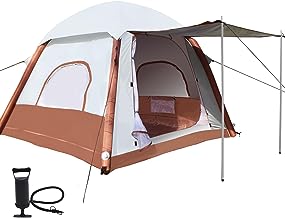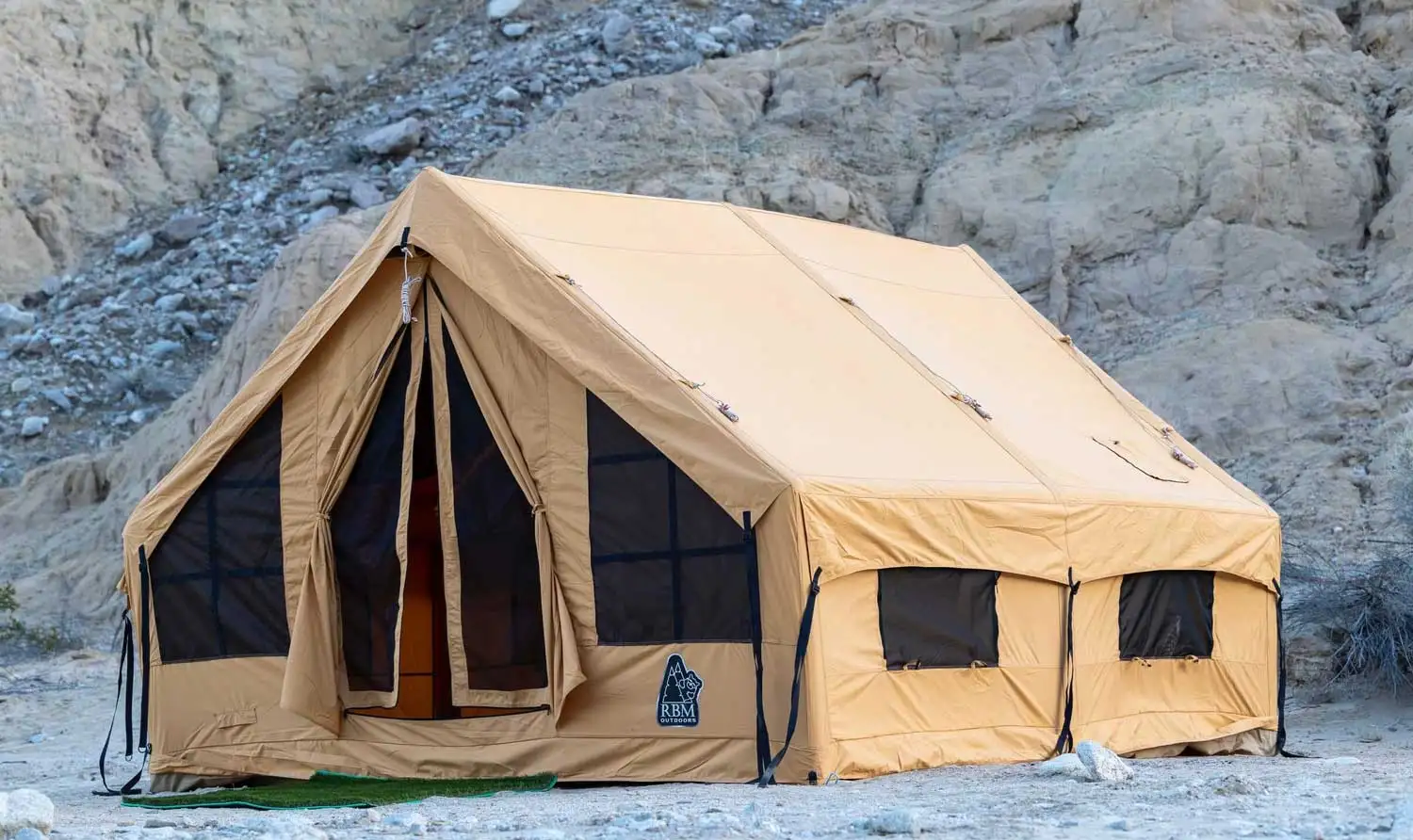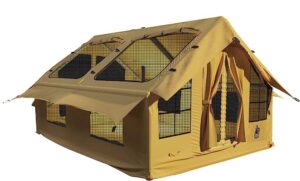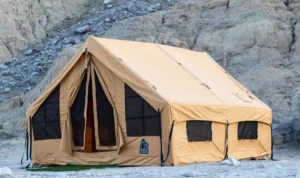Different types of air tents, such as cabin-style tents, dome tents, and tunnel tents
When it comes to camping, finding the right tent is of utmost importance. The development of air tents has revolutionized the camping experience, providing campers with a lightweight and convenient alternative to traditional tents. Air tents are designed with inflatable beams instead of traditional poles, making setup quick and hassle-free.
In this section, we will explore the different types of inflatable tents available on the market today. One popular type of air tent is the cabin-style tent.

These tents are known for their spaciousness and vertical walls, which create a more comfortable living space. Cabin-style air tents often feature multiple rooms or dividers, allowing campers to have separate areas for sleeping and storage.
The vertical walls also contribute to increased headroom throughout the tent, making it easier to move around without feeling cramped. Another widely-used type of air tent is the dome tent.
Dome tents are recognized for their sturdy structure and excellent wind resistance. The unique shape allows for better stability in challenging weather conditions as it evenly distributes wind forces across its frame.
Dome-shaped air tents typically have a central peak that provides additional height in the center of the tent while gradually sloping down towards the sides. This design not only provides ample headroom but also helps prevent rainwater from pooling on top of the tent during inclement weather.
Tunnel tents are another popular choice among campers seeking versatility and adaptability in their camping gear. As their name suggests, these tents have a long tunnel-like shape with curved sides that provide excellent interior space utilization while remaining aerodynamic against strong winds.
Tunnel-shaped air tents often feature multiple entrances at each end along with ample ventilation options throughout for improved airflow. Each type of air tent offers its own set of advantages based on individual preferences and specific camping needs.
Whether you prioritize spaciousness, wind resistance, or flexibility in setup options, understanding these different types will help you make an informed decision when selecting an air tent for your next outdoor adventure. In the next section, we will delve into the various features that make air tents an appealing choice for campers.
Features of air tents, such as air-tight construction, waterproof fabric, and UV protection
Air tents boast a range of features that make them a popular choice among camping enthusiasts. One of the key features is their air-tight construction, which sets them apart from traditional tents.
These tents are specifically designed to be inflated using an air pump, eliminating the need for tedious assembly with poles and connectors. The air-tight construction ensures that once the tent is inflated, it remains sturdy and stable throughout your camping experience.
In addition to their innovative construction, air tents also offer superior protection against the elements. The fabrics used in these tents are often waterproof, ensuring that you stay dry even during heavy rain showers.

This is especially crucial when you’re out in nature and unexpected weather changes can occur. The waterproof fabric provides an effective barrier against moisture, preventing any water seepage into the tent’s interior.
Furthermore, air tents frequently incorporate UV protection into their design. The fabric used typically has a high UPF (Ultraviolet Protection Factor) rating to shield occupants from harmful UV rays emitted by the sun.
This feature not only protects your skin but also helps to preserve the longevity of the tent itself by reducing sun damage over time. With this added protection, you can confidently enjoy your camping experience without worrying about potential sunburn or fading of colors on your tent’s exterior.
The combination of air-tight construction, waterproof fabric, and UV protection makes air tents a reliable choice for campers seeking both durability and comfort in their shelter options. These features provide peace of mind when faced with unpredictable weather conditions or extended stays in outdoor environments where exposure to sunlight is unavoidable.
Benefits of air tents, such as easy setup, portability, and spaciousness
When it comes to camping, one of the most important factors to consider is the ease of setting up your tent. This is where air tents truly shine. Unlike traditional tents that require poles and lengthy assembly processes, air tents offer a hassle-free setup experience.
With an air tent, all you need is a pump and a few minutes of your time. Simply inflate the tent using the pump, and within moments, it will take shape before your eyes.
The convenience of this setup method cannot be overstated, especially after a long day of hiking or exploring the wilderness. Portability is another outstanding feature that sets air tents apart from their conventional counterparts.
Air tents are designed with lightweight materials that make them highly portable and easy to transport from one campsite to another. Their compact size when deflated allows for convenient storage in backpacks or car trunks.
Additionally, many models come with their own carrying bags for even easier transportation. So whether you’re embarking on a long hiking trip or planning a family camping adventure in multiple locations, an air tent ensures that you won’t be burdened by heavy loads.
In addition to being effortless to set up and portable, air tents also offer remarkable spaciousness compared to traditional tents. Due to their inflatable structure, these tents can utilize every inch of space effectively without any intrusive poles or awkward angles limiting internal headroom or floor area.

This means there’s more room for sleeping bags, gear storage, and even standing up comfortably inside the tent during inclement weather conditions. Moreover, many air tent models come with multiple rooms or dividers that allow for privacy within larger groups or families sharing the same space.
When considering the benefits of choosing an air tent over conventional options for your camping adventures, it’s hard not to appreciate their easy setup process that saves time and effort after tiring outdoor activities. The portability aspect provides flexibility in terms of transport while maintaining lightweight convenience throughout your journey.
Furthermore, the spaciousness offered by air tents ensures a comfortable camping experience with ample room for rest and relaxation. With these advantages, it’s clear why air tents have become increasingly popular among outdoor enthusiasts seeking a convenient and enjoyable camping experience.
Drawbacks of air tents, such as cost and limited durability in extreme weather conditions
While air tents offer numerous advantages, it is important to acknowledge some of the drawbacks associated with these innovative camping shelters.
One significant drawback is the cost of air tents. Compared to traditional tents, air tents tend to be more expensive due to their advanced construction and materials.
The incorporation of air beams instead of traditional poles contributes to the higher price tag. However, it is essential to consider this cost in terms of long-term investment and the benefits that come with owning an air tent.
Another potential limitation when using an air tent is its limited durability in extreme weather conditions. Although modern designs have improved significantly in terms of resilience, inflatable tents may not be as sturdy as some traditional options when faced with harsh elements such as strong winds or heavy rainfall.
In extremely windy conditions, the inflatable nature of the beams can make them susceptible to damage or deflation if not properly secured or staked down. Moreover, while most air tents are made from durable materials that provide good water resistance, prolonged exposure to heavy rain or snow can potentially weaken their waterproof capabilities over time.
This makes them less suitable for camping in areas prone to severe weather conditions without additional precautions. Despite these drawbacks, it is important to note that advancements continue to be made in the design and engineering of air tents.
Manufacturers are continually innovating and introducing new features that enhance their durability and performance under challenging circumstances. Additionally, by being mindful of these limitations and taking necessary precautions when selecting a campsite or setting up an air tent, many potential risks can be mitigated effectively.
Tips on choosing the right air tent for your needs, such as considering the size of your group, the climate you’ll be camping in, and your budget
When it comes to choosing the right air tent for your camping adventures, there are several factors you should consider to ensure a comfortable and enjoyable experience. First and foremost, you need to think about the size of your camping group. Are you planning a solo trip or will you be accompanied by family or friends?
Determining the number of people who will be sharing the tent with you is crucial as it directly affects the size and capacity of the air tent you should choose. For smaller groups or solo campers, a compact two-person air tent would suffice.
These tents are lightweight, easy to set up, and perfect for backpacking trips. However, if you’re planning a family camping excursion or if extra space is important to you, consider larger tents that can accommodate four or more people comfortably.
Keep in mind that bigger tents tend to require more time and effort to set up compared to their smaller counterparts. Another important factor in choosing an air tent is considering the climate conditions in which you’ll be camping.
If you often venture into areas with unpredictable weather patterns or extreme conditions such as heavy rain or strong winds, it’s essential to look for an air tent that offers superior weather resistance. Ensure that the tent is constructed from durable materials with high-quality waterproofing capabilities.
Additionally, features like robust anchoring systems will provide stability during gusty winds. Your budget plays a significant role in selecting an air tent.
While investing in a top-of-the-line model might seem appealing, it’s important to find a balance between quality and affordability. Settle on a budget range before beginning your search and compare different options within that price bracket.
Look for tents that offer good value for money by providing essential features without straining your finances. By taking into account factors such as group size, climate conditions, and budget constraints when selecting an air tent, you can ensure that your camping experience will be both comfortable and suitable for your specific needs.
Instructions on how to set up an air tent, including how to inflate the tent, stake it down, and secure the doors and windows
Setting up an air tent can seem daunting at first, but with the right instructions, it becomes a straightforward process. To ensure a successful setup, follow these step-by-step guidelines:
1. Inflating the Tent: Before starting, unroll the tent and make sure you have all the necessary components such as the air pump and tent pegs.
Most air tents come with built-in inflation systems or separate pumps. Begin by attaching the pump to the designated valve on the tent.
Some tents have multiple inflation points for different sections of the tent; make sure to inflate them in sequence according to any provided instructions. Start pumping or activate the built-in system to fill each section of the tent with air.
It’s essential to monitor pressure levels to avoid overinflating and potentially damaging your tent. 2. Staking it Down:
Once your air tent is fully inflated, it’s time to secure it in place using stakes or pegs included with your purchase. Locate each corner of your tent and use a mallet or similar tool to drive the stakes into the ground at a 45-degree angle, ensuring they are firmly anchored.
For added stability, consider placing additional stakes at intervals along the sides and guy-out points if applicable. 3. Securing Doors and Windows:
After staking down your tent, proceed to secure its various openings such as doors and windows for protection against wind and rain infiltration. Many air tents feature hook-and-loop closures or zippers for easy access while providing necessary protection from insects or adverse weather conditions.
To secure doors, ensure they are closed tightly by aligning their zippers correctly before smoothly pulling them shut from top to bottom. Windows typically incorporate toggle mechanisms that allow you to roll up or fasten them partially open for ventilation purposes when desired.
Remember that proper sealing of all openings is vital for maintaining optimal comfort inside your air tent while ensuring protection from external elements. By following these instructions carefully, you’ll be able to set up your air tent efficiently, allowing you to begin enjoying your camping experience in no time.
Safety tips for using an air tent, such as staking the tent down in windy conditions, preventing condensation, and keeping the tent clean and dry
Safety Tips for Using an Air Tent In order to ensure a safe and enjoyable camping experience with your air tent, it is crucial to follow some essential safety tips.
Firstly, staking the tent down in windy conditions is essential to prevent any mishaps. Air tents, while sturdy and secure, can still be susceptible to strong gusts of wind.
Before setting up your tent, assess the terrain and choose a suitable spot that offers some natural protection against wind. Once you’ve found the ideal location, make sure to stake down all corners of the tent securely.
This will help maintain stability and minimize the risk of your tent being blown away. Another important aspect often overlooked is preventing condensation inside your air tent.
Condensation can build up during colder nights or in humid environments, leading to unpleasant dampness inside the tent. To combat this issue, it’s wise to ensure proper ventilation by keeping windows or vents slightly open.
This allows fresh air circulation and reduces moisture buildup within the tent fabric. Additionally, using a groundsheet underneath your air tent can help insulate against cold ground temperatures and minimize condensation from seeping through.
Moreover, keeping your air tent clean and dry goes hand in hand with maintaining its longevity and safety standards. Regularly sweeping out any debris like dirt or leaves from both inside and outside the tent is essential for preserving its quality.
Ensure that no sharp objects are left on the ground before pitching your tent as they may puncture or damage its base material over time. After each camping trip, it is advisable to thoroughly dry out your air tent before storing it away to prevent mold formation or unpleasant odors that may arise due to moisture retention.
By diligently following these safety tips – staking down in windy conditions, preventing condensation with proper ventilation techniques, as well as keeping the air tent clean and dry – you will ensure a secure environment for camping adventures without compromising on comfort or durability. Taking these precautions will not only enhance your camping experience but also contribute to the extended lifespan of your air tent, allowing you to enjoy countless trips in the great outdoors reliably and safely.
Conclusion by Acme Toy Company
Air tents have revolutionized the camping experience with their innovative design and practical features. The different types of air tents available, including cabin-style tents, dome tents, and tunnel tents, offer campers a wide range of choices to suit their preferences and needs.
Whether you are a solo adventurer or a family looking for ample space, there is an air tent out there that will meet your requirements. The numerous benefits of air tents make them highly desirable for camping enthusiasts.
Their easy setup process saves precious time and energy, allowing campers to focus on enjoying the great outdoors rather than struggling with complicated tent assembly. Additionally, the portability of air tents makes them ideal for those who enjoy exploring various campgrounds or embarking on adventurous trips where mobility is key.
Furthermore, the spaciousness offered by these tents ensures that you can comfortably accommodate yourself and your camping companions without feeling cramped or restricted. It is essential to note some drawbacks associated with air tents as well.
While they provide excellent protection in most weather conditions, they may not be as durable as traditional pole tents in extreme weather situations such as heavy snowfall or strong winds. Moreover, the initial investment required to purchase an air tent may be higher compared to other tent options on the market.
However, when considering their convenience and long-term benefits such as ease of use and durability under normal conditions, this investment becomes worthwhile for serious campers. Embracing the world of air tents opens up new possibilities for outdoor enthusiasts seeking comfort and convenience during their camping experiences.
These state-of-the-art shelters combine advanced technology with thoughtful design features to create a home away from home amid nature’s beauty. So go ahead and embark on your next adventure armed with an air tent – it’s time to elevate your camping game!




